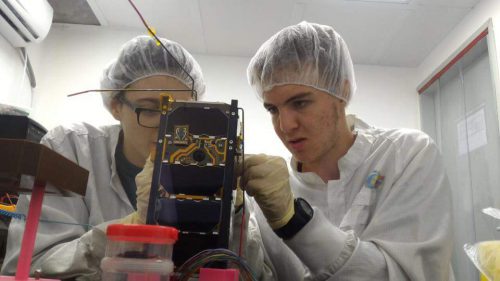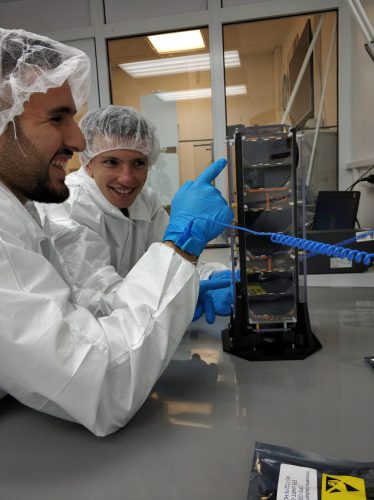Dokifat 3 was built by high school students from the Herzliya Science Center and the Shaar HaNegev High School and is designed to be used by students from all over the country in making observations of the Earth * It is larger and more complex than its predecessors

Dokifat 3, the third satellite in the series of Israeli student satellites, is expected to be launched into space from India on December 11.12.2019, XNUMX. This is what Sharon Mashal, coordinator of the satellite and space program at the Herzliya Science Center, says in an interview with the Hidan website. The project is financed, among others, by the Municipality of Herzliya, the Israel Space Agency at the Ministry of Science and the YKA Foundation.
The Dokifat 3 satellite, built by high school students from the Herzliya Science Center and the Shaar HaNegev High School, is a photography satellite that is used for ecological research of the Earth from space. The size of the satellite is 10x10x30 cm 3U)) and it weighs 2.3 kg, the students worked for two years to build it. The satellite will be launched from India on 11.12.19.
"The students' work included planning the satellite, writing the airborne and ground software and testing it until preparing the satellite for launch." Mashal explains and adds that during their work the students face various scientific and technological challenges, such as designing and writing airborne software to manage the satellite systems and to operate its scientific mission, managing the satellite's energy resources, the communication system and more. The satellite's scientific mission poses additional challenges.
"Dokifat 3 will be a remote sensing satellite with which students from all schools in Israel will be able to conduct experiments that require observation of the Earth. The satellite is defined as a platform for ecological studies such as pollution of water sources, monitoring of forests and more. This mission is more complex than the missions of Dokifat 1 (relay for radio amateurs) and Dokifat 2 (measurement of plasma density in the thermosphere as part of a European Space Agency project.) Also, the satellite's mission poses additional challenges. In order to photograph the Earth, it is necessary to stabilize the satellite in space, not an easy task at all that requires control of the direction of the satellite in its orbit. Also, due to our modest resources as an educational framework, students are required to think of creative solutions to various problems such as the data transfer rate resulting from a narrow tape width and limiting us in the amount of information that the satellite can transmit to the ground station while it passes over us. The students thought of creative and innovative ways to deal with the problem and created a mechanism for image processing on the satellite, which includes selecting the relevant images, compressing them and sending them to Earth. Also, the students were helped by experts in Israel and around the world to build appropriate communication systems and built software to manage the information on the satellite and the ground station. "

We spoke with two of the students participating in the project. Gal Levin, a twelfth grade student at Engineers High School in Herzliya, in addition to her duties in developing the satellite, also serves as the CEO of the project on behalf of the students: "I joined the project when I was in the ninth grade. I joined the communications team and there I was very active in the planning of Dokifat 2. I specialized in the field of ADCS - the system that stabilizes the satellite. We learned a lot from Dokifat 2 and from the experience in operation I drew conclusions so that we can improve Dokifat 3 which was just recently sent to the launch site in India."
Who are the students participating in the project?
"These are XNUMXth to XNUMXth grade students from Herzliya and the Negev Gate, about fifty students in Herzliya and about ten more in the Negev. The students from Herzliya meet twice a week, sometimes even more during stressful periods in the project. We work on the satellites, plan them, program them, and test them, and we also have to plan and build the ground system to receive the satellite, and after the launch we communicate with it on a daily basis."
How do you feel about the launch?
"We are all excited, we worked very hard on this, we each invested many hours and are especially excited to wait for the first pass and the first reception."
What does your role as CEO mean?
"We felt it was a student project, we wanted to take on tasks beyond the technical side. We have a board that is made up of students, where we also deal with areas like external relations, making sure all the students feel good about the work, taking care of them if they have problems. In short, all kinds of essential tasks that are not related to the satellite itself. As CEO I am the head of the board and within the board there is another vice president and three board members who are all elected by the project's students."
Ilai Naftali, also a 2th grade student, at the Engineering High School in Herzliya, I joined the project in the 3th grade but that was already when Dokifat 2 was sent to the launch facility. I was pre-assigned to work on Dokifat XNUMX. I gained my experience running Dokifat XNUMX. Because it was a low-orbiting satellite, it burned up in the atmosphere, but by then it had survived a year and a half instead of a few months. Therefore, we had a lot of time to study it and understand how to develop the next satellite."
"Dokifat 3 is a tiny satellite. What is different about it from the previous satellites is the camera with which we will photograph the Earth from space and we will be able to carry out ecological experiments. We can see changes of the earth's surface in the different seasons, over time, storms. It will be possible to obtain a lot of information from the images from space and we will also be able to help farmers"
"The work on Dokifat 3 started in the 2th grade when I joined the project. Between it learning the appropriate materials and the environment of what it's like to work on a satellite. The whole process took a year and a bit - a lot of experience on Dokifat 3 when it was in space and a lot of drawing conclusions and learning what was good in the development and what was less good. Around the beginning of my XNUMXth year, I really started working on Dokifat XNUMX. The satellite itself was already in the lab, I could test my code and get into a much more massive development. The development work on the satellite involves a lot of tests and experiments and lasted over a year, until recently, and now we are standing before the launch."
And how do you feel about the launch?
"Me and the other students working on the project are connected to what we did, excited by the launch, to see what we did in action. Because until now we have seen everything in an optimal laboratory environment. It's true that we did a lot of experiments simulating the space environment and the conditions it is going to face, but this is still not the real moment."
How did participating in the construction of the satellite promote you?
"We had to learn many things while working on the project, especially in physics. In the end it is also material that is studied in school and it turned out that what I did in the XNUMXth or XNUMXth grade I suddenly encountered in studies for matriculation. I learned a lot of material even unrelated to the curriculum that I am happy to know. In the army I try to focus on areas of technological development. After the satellite I realized that I enjoy it a lot, I hope to continue it."
More of the topic in Hayadan:
- Dokifat 3 which is currently under development; Will be part of a cast of Israeli student satellites of the Israel Space Agency (a prediction that in the end did not come true)
- Dokifat satellites brought the Science Center and Herzliya Municipality the Marco Polo Society Award
- The Israeli student satellite Dokifat 2 was successfully launched into space today
- Not a single screw in the Dokifat 2 satellite was screwed in by an adult, and not a single line of code was written by an adult
- The administrator of the students' satellite Dokifat 1 Mead Parinta: the satellite works perfectly * Yonatan Weintraub, SpaceIL: projects like this encourage science and engineering studies

4 תגובות
Good Uncle Tovia
The differences in the seasons on the earth are not due to the change in the distance between the earth and the sun, but because of the tilt angle of the earth -23.5 degrees. The angle causes the earth to tilt diagonally towards the sun and as a result the surface area that is exposed to the sun's light and heat is larger, so that in the summer the light and heat of the sun that reaches the northern hemisphere will reach it over a longer period of time - this is also the reason why the days are longer in the summer.
During this time, winter will prevail in the southern half where the time of exposure to light and heat will be lower... In autumn and spring there will be a fairly equal distribution of heat and light between the parts of the earth...
Hello Eli, You can see the rotation of the earth around itself both from space and from the earth, regarding 'huge speed' the rotation is not so noticeable to the eye because it lasts 24 hours in which the earth completes one rotation around itself, this is actually the reason for the differences between day and night.
The rotation around the sun lasts a year and therefore it is even more difficult for us to notice it, the differences in the seasons, for example, are due to the elliptical movement of the earth around the sun which causes temperature differences due to the different distance from the sun.
I hope you are wise, yours, the good David Tovia.
It is said that the earth rotates at enormous speed around itself and around the sun.
So why don't you see this rotation in video footage of spacecraft near the moon or even Mars.
amazing Well done !